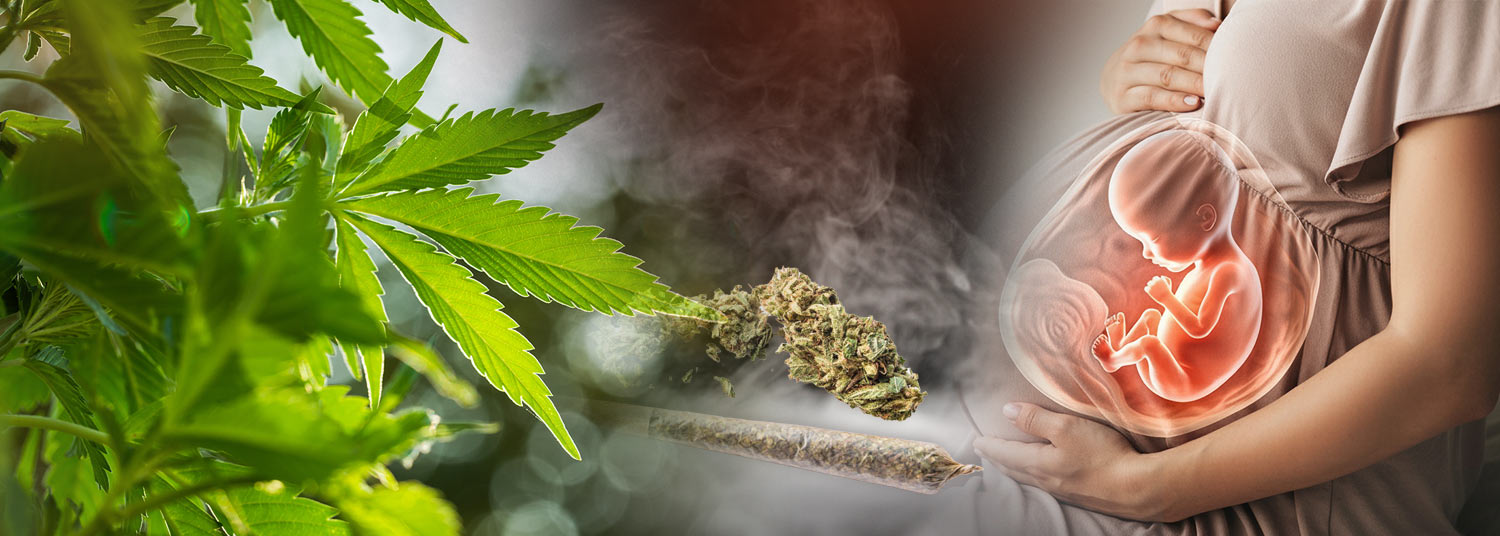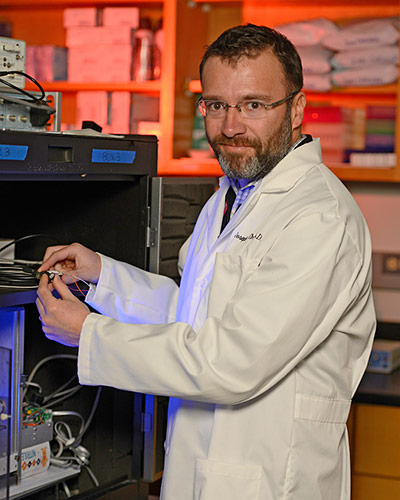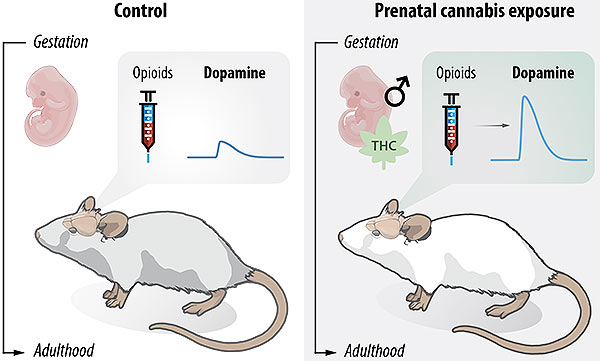News — University of Maryland School of Medicine Researchers Identify Neurobiological Changes Leading to Increase Release of the Brain Chemical Dopamine and Its Target Neurons Linked to Addiction-Like Behavior
With the increased legalization of recreational cannabis, as many as 1 in 5 pregnant women in the U.S. are now using the drug to help with morning sickness, lower back pain or anxiety. Evidence has been growing, however, to suggest that tetrahydrocannabinol (THC), the main psychoactive ingredient in cannabis, poses risks to the developing fetus by impacting brain development. Now a new study finds that this could increase the risk of addiction to opioids later in life.
The preclinical animal study, led by researchers at the University of Maryland School of Medicine, was published in the journal . It found that prenatal exposure to THC causes a rewiring of the fetal brain. THC caused certain brain cells, called dopamine neurons, to respond in a hyperactive way, causing a heightened increase in dopamine release. This was accompanied by heightened neuronal responsiveness to cues associated with rewards like a light turning on to indicate that food or an opioid drug was available.
“Doctors are contending with an explosion of cannabis use, and the THC content has quadrupled from what it was a generation ago,” said study corresponding author , a Professor of Neurobiology and Psychiatry at the University of Maryland School of Medicine. “It demonstrates the enduring consequences that prenatal cannabis exposure exerts on the brain’s reward system, which ultimately results in a neurobiological vulnerability to opioid drugs.”
The recommends that doctors counsel patients on concerns about potential adverse health consequences of continued use of cannabis during pregnancy. Dr. Cheer and others doing research on THC exposure during pregnancy are racing to learn more about the health consequences on developing fetuses to help doctors better counsel their patients on the drug’s effects.
To conduct this new study, he and his colleagues found that fetuses exposed to a moderately low dose of THC (equivalent to their mothers smoking one to two joints per day) developed changes in how their reward system functioned, causing them to develop an at-risk phenotype for opioid seeking. Animals previously exposed to THC in utero display a dramatically increased motivation to press a lever that would deliver a dose of opioid drugs compared to those that were not previously exposed to THC.
When THC-exposed animals reached early adulthood, they were more likely to show enhanced opioid-seeking and were more likely to relapse upon opioid-associated environmental cues compared to those animals who were not exposed to THC in the womb. They were also more likely to develop persistent addiction-like behaviors.
In a follow-up experiment, the researchers implanted tiny sensors in the animals’ brains and measured heightened dopamine release, accompanied by activity in neurons that over-represented opioid-related cues, in the rats exhibiting strong addiction-like behaviors.
“These observations support the hypothesis of a hypersensitized ‘wanting’ system that develops in the brain after exposure to THC during prenatal development,“ said Dr. Cheer. “Interestingly, we found that this opioid-seeking phenotype occurs significantly more in males compared to females, and we are currently performing research with our colleagues at UMSOM, to determine why this is the case.”
Dr. Cheer’s previous work published in the journal found prenatal exposure to THC makes the brain’s dopamine neurons hyperactive, which may contribute to an increased risk of psychiatric disorders like schizophrenia. His work has been independently verified by three independent laboratories throughout the world.
Along with his colleague , Professor of Neurobiology at UMSOM, Dr. Cheer serves as the co-director of the , which is part of UMSOM’s . The two are working with a team of researchers to investigate the enduring effects of drug and alcohol exposure in the womb.
“We need to more fully understand the enduring effects of THC exposure in the womb and whether we can reverse some of the deleterious effects through CRISPR-based gene therapies or repurposed drugs,” said UMSOM Dean , who is the John Z. and Akiko K. Bowers Distinguished Professor and vice president for medical affairs at the University of Maryland, Baltimore. “We also need to provide better advice to pregnant patients, many of whom are using cannabis to help control anxiety because they think this drug is safer for their baby than traditional anti-anxiety medications.”
The study was funded by the National Institute on Drug Abuse (Grant: R01 DA022340) (Grant: K99 DA060209). UMSOM faculty member a research associate in Neurobiology, was the first author of the paper.
About the University of Maryland School of Medicine
Now in its third century, the University of Maryland School of Medicine was chartered in 1807 as the first public medical school in the United States. It continues today as one of the fastest growing, top-tier biomedical research enterprises in the world -- with 46 academic departments, centers, institutes, and programs, and a faculty of more than 3,000 physicians, scientists, and allied health professionals, including members of the National Academy of Medicine and the National Academy of Sciences, and a distinguished two-time winner of the Albert E. Lasker Award in Medical Research. With an operating budget of more than $1.2 billion, the School of Medicine works closely in partnership with the University of Maryland Medical Center and Medical System to provide research-intensive, academic, and clinically based care for nearly 2 million patients each year. The School of Medicine has more than $500 million in extramural funding, with most of its academic departments highly ranked among all medical schools in the nation in research funding. As one of the seven professional schools that make up the University of Maryland, Baltimore campus, the School of Medicine has a total population of nearly 9,000 faculty and staff, including 2,500 students, trainees, residents, and fellows. The School of Medicine, which ranks as the 8th highest among public medical schools in research productivity (according to the Association of American Medical Colleges profile) is an innovator in translational medicine, with 606 active patents and 52 start-up companies. In the latest U.S. �鶹��ý & World Report ranking of the Best Medical Schools, published in 2023, the UM School of Medicine is ranked #10 among the 92 public medical schools in the U.S., and in the top 16 percent (#32) of all 192 public and private U.S. medical schools. The School of Medicine works locally, nationally, and globally, with research and treatment facilities in 36 countries around the world. Visit
MEDIA CONTACT
Register for reporter access to contact detailsArticle Multimedia

Credit:
Caption:

Credit:
Caption: Joseph Cheer, PhD

Credit:
Caption: This illustration shows that male animals exposed to THC in the womb experience a greater surge in the “reward-seeking” brain chemical dopamine when exposed to opioid drugs as adolescents compared to those that were never exposed to THC.

Credit:
Caption: Mark T. Gladwin, MD
CITATIONS
;

